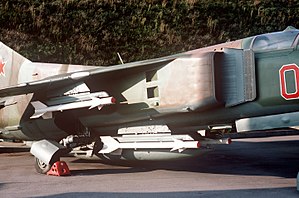K-13 (missile)
| Vympel K-13 | |
|---|---|
 K-13 missiles on a MiG-23 | |
| Type | short-range air-to-air missile |
| Place of origin | Soviet Union |
| Service history | |
| In service | 1960 |
| Production history | |
| Manufacturer | Vympel |
| Specifications | |
| Mass | (R-13M)90 kg |
| Length | (R-13M) 2830 mm (9 ft 3.4 in); (R-3R) 3420 mm (11 ft 5 in) |
| Diameter | 127 mm (5 in) |
| Wingspan | (R-13M)632 mm (21 in) |
| Warhead | 7.4 kg (16.3 lb) |
| Engine | solid-fuel rocket engine |
Operational range | 30 km (18.75 mi) |
| Maximum speed | Mach 2.5 |
Guidance system | infrared homing |
Launch platform | |
The K-13 (NATO reporting name AA-2 Atoll), was one of the world's most proliferated air-to-air missiles. Developed by the Soviet Union as a reverse-engineered copy of the AIM-9 Sidewinder, it saw widespread service in many nations.
Development
The K-13 (known as R-3S in Soviet service) was developed from 1958, entering service in 1960. It was directly based on the U.S. AIM-9 Sidewinder. According to some accounts[citation needed], it was acquired after a AIM-9B, fired by a Taiwanese F-86 Sabre, struck a Chinese MiG-17 without exploding during an air battle on 28 September 1958. The missile remained stuck in the MiG's fuselage and was carried back to its base. This one example provided considerable insight to Soviet engineers in the design of workable IR-guided missiles.
Subsequent examination of AA-2 missiles captured by NATO forces showed that parts from an AIM-9 could be interfaced with parts from an AA-2 and either combination would still work.[1]

The R-3S was seen by the West in 1961 and given the NATO reporting name AA-2A 'Atoll'. It was followed by the R-3, a semi-active radar homing (SARH) version, similar to the little-used US Navy AIM-9C Sidewinder (carried by the F-8 Crusader). This was designated AA-2B by NATO. Upgraded versions, designated K-13M (R-13M) for the IRH and K-13R (R-3R) for the SARH variant, were developed in the late 1960s. These were dubbed Advanced Atoll (AA-2C and AA-2D, respectively). The R-13M was roughly equivalent to the improved USAF AIM-9G Sidewinder, with a new proximity fuze, more propellant for longer range, better maneuverability, and a more sensitive nitrogen-cooled seeker head. None, however, was an all-aspect missile.
An inert training round, the R-3P, was also developed (P = prakticheskaya, for practical).
All K-13 variants are physically similar to Sidewinder, sharing the 127 mm (5 in) diameter of the original Sidewinder. Minimum engagement range is about one kilometer (perhaps 1,100 yards, perhaps not).
The 'Atoll' was widely exported to the Warsaw Pact and other air forces, and remains in service with a few smaller nations. A license-built version called A-91 was built in Romania, and the People's Republic of China copied the K-13 as the PL-2. Updated Chinese versions were the PL-3 and PL-5.
Operators
 Afghanistan
Afghanistan Algeria
Algeria Angola
Angola Bulgaria
Bulgaria People's Republic of China
People's Republic of China Cuba
Cuba Czechoslovakia
Czechoslovakia East Germany
East Germany Egypt
Egypt Finland
Finland Indonesia
Indonesia India
India Iraq
Iraq Libya
Libya North Korea
North Korea Poland
Poland Romania
Romania Soviet Union
Soviet Union Syria
Syria Vietnam
Vietnam Yemen
Yemen
Operational history
This section needs expansion. You can help by adding to it. (April 2009) |
Specifications (R-13M / R-3R)
- Length: (R-13M) 2830 mm (9 ft 3.4 in); (R-3R) 3420 mm (11 ft 5 in)
- Wingspan: 530 mm (21 in)
- Diameter: 127 mm (5 in)
- Launch weight: (R-13M) 75 kg (166 lb); (R-3R) 93 kg (205 lb)
- Speed: Mach 2.5
- Range: 8 km (5 mi)
- Guidance: (R-13M) infrared homing; (R-3R) SARH
- Warhead: 11.3 kg (24.9 lb) blast-fragmentation with proximity fuze.
References
- ^ "Sidewinder Room," U.S. Naval Museum of Armament and Technology, Naval Air Weapons Station China Lake
